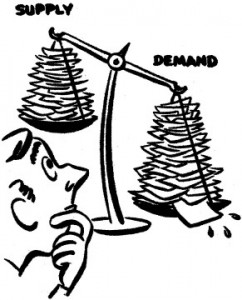
Low housing inventory seems to have been the primary reason for last week's disappointing existing-home sales data.
By Peter Ricci
As everyone has probably heard by now, existing-home sales were a bit tepid in June, falling 5.4 percent from May according to the latest data from the National Association of Realtors.
The reason for the decline represented one of the more spectacular switch-ups in recent economic memory; the same housing market plagued by too much inventory now has the exact opposite problem – too little inventory!
As the Wall Street Journal pointed out in a recent article, inventory in June fell another 3 percent from May to just 2.12 million units, which is 24 percent lower than in June 2011 and the largest annual drop in 30 years.
A number of factors have contributed to the historic inventory drop, among them: slower action by banks to sell REOs, a greater incentive to rent – rather than sell – investor-purchased properties and certain traits of today’s sellers, namely negative equity and expectations that prices will improve (why sell now when prices could rise in a couple years?).
There are two sides to the inventory debate, one good and one bad. First, the bad – distressed properties have made up a disproportionate share of home sales in recent months, so it was inevitable that as the inventory of distressed residences fell, so would existing-home sales data, considering that the chief source of demand for housing in 2012 has been ridiculously discounted distressed homes. And the Journal does point out some compelling evidence to that fact – in the West, where distressed inventories fell, the sales for homes priced lower than $100,000 dropped by 36 percent.
“If you look at where sales declined the most, it’s in the same places where inventory declined the most,” said Jed Kolko, Trulia’s chief economist.
But now the good – and there is, arguably, quite a bit of good to today’s inventory numbers. For one, it benefits sellers, who have long suffered the slings and arrows of the post-boom housing market. Prices responded positively to June’s low inventory (median price was up by nearly 8 percent), and fewer properties gives sellers more bargaining power during closings. Also, on the buyer end, rising prices may influence buyers sitting on the fence to enter the market and finally purchase a home; after all, for the first time in years, buyers cannot expect prices to fall any further.
Also, home builders could also benefit from the current inventory levels. As Michael Sklarz, president of Collateral Analytics, put it in the Journal article, “People can’t find inventory that they want, so they say, ‘I’m just going to buy the house down the block that’s brand new. I don’t have to go through the whole torture.”
And we’ll soon find out if there’s any truth to that latter hypothesis – new residential sales data will be out on Wednesday from the Census Bureau, so stay tuned!
